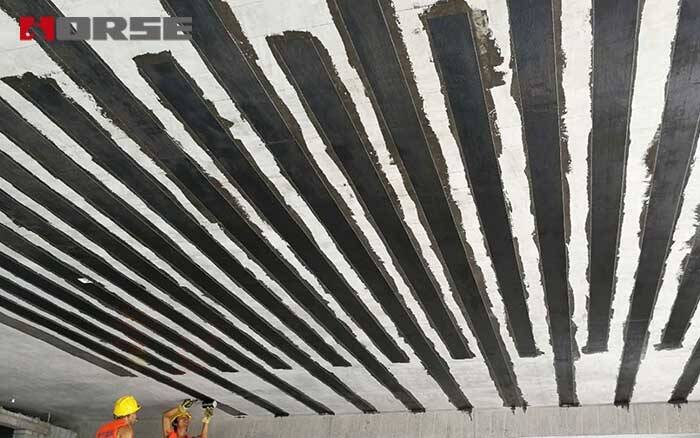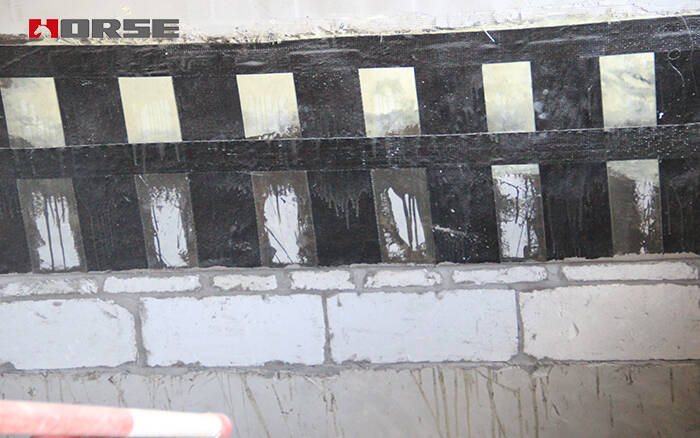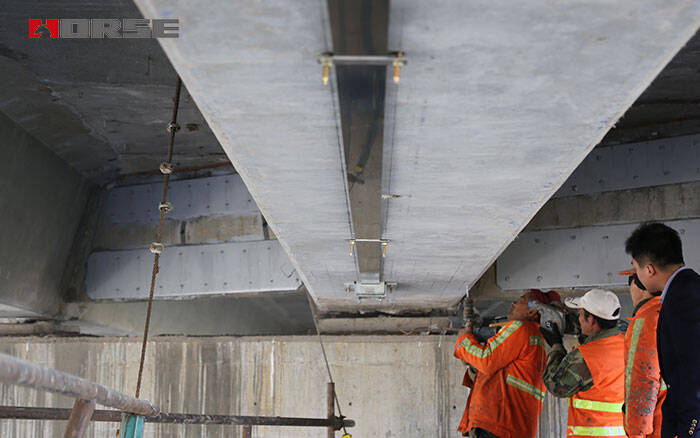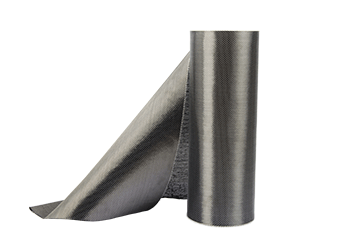Solutions
Horse Construction offers full range of structural strengthening materials with technical supports, documentation supports, products supports, project supports.
carbon fiber reinforced polymer in structural rstrengthening
The destruction theory of reinforced concrete structure
(1) Less reinforcement failure: When the structure reaches the limit state, the longitudinal reinforcement in the tension zone of the member yields first. Due to the small amount of reinforcement of the member, although the steel bar has a clear yield point, as the load increases, the stress of the steel bar quickly reaches the ultimate strength, and the concrete in the compression zone does not reach the ultimate strength at this time. For concrete failure, this kind of situation is called low-fracture failure, also called brittle failure. In order to avoid the failure of less reinforcement, the reinforcement ratio of longitudinal reinforcement should not be less than the minimum reinforcement ratio during structural design.
(2) Reinforcement failure: When the structure is destroyed, the reinforcement in the tension zone first reaches the yield strength, and the concrete in the compression zone is crushed. This situation is called reinforcement failure, also known as ductile failure, which is the ideal form of structural failure.
(3) Super-reinforcement failure: When the structure reaches the ultimate strength, the concrete in the compression zone is crushed first, and the reinforcement in the tension zone does not reach the yield strength. This kind of situation is called super-fracture failure, also called brittle failure. Since the height of the compression zone of concrete is proportional to the longitudinal reinforcement ratio of the tension zone, in order to prevent over-reinforcement failure, the relative compression zone height of concrete should be controlled during design ξ≤ξb. For some structures with high seismic requirements, the structure needs to have higher ductility, and the corresponding ξ is also smaller.

Carbon fiber reinforced polymer reinforcement analysis
In terms of material strength, the tensile strength of carbon fiber reinforced polymer is 10 times that of steel, but the density is lower than that of steel. In addition, the carbon fiber reinforced polymer has good corrosion resistance and durability, which can ensure that the structure after the carbon fiber reinforced polymer is pasted can reach the strength required by the design for a long time.
Although the method of sticking the carbon fiber reinforced polymer structure has many advantages, this method also has certain disadvantages. Because carbon fiber reinforced polymer is a flexible material, sticking carbon fiber reinforced polymer can hardly improve the rigidity of the structure, and at the same time, the control of structural deformation is also very limited. For the flexural members, the reinforcement ratio of the tensile structure of the original structure has a great influence on the reinforcement effect of the structure after the carbon fiber reinforced polymer is pasted.
In addition, in the various codes, for bending members, the increase in the bending capacity of the normal section of the structure reinforced with carbon fiber reinforced polymer must be less than 40%. Why do we need to control the increase in the carrying capacity of the structure reinforced by carbon fiber reinforced polymer in the specification? This question has not yet had a perfect answer.
The destruction form of the structure reinforced with carbon fiber reinforced polymer
The structure reinforced by the carbon fiber reinforced polymer method may be damaged in the following ways:
(1) The amount of structural reinforcement is too large. In this case, the structure's failure form is similar to the ordinary reinforced concrete structure's super-reinforcement failure. The concrete in the compression zone is first crushed.
The stress of the tendon is small and it has not reached yield. The relative height of the compression zone ξ≤ξb belongs to brittle failure. In order to avoid this situation, the height of the structure relative to the pressure zone after reinforcement treatment is ξbs≤0.85ξb. The "fiber meets the material specifications" requires the relative compression zone height before the reinforced member ξ≤0.8ξb.
(2) The reinforcement of the structure is slightly larger. The longitudinal reinforcement in the tension zone yields first, and then the concrete in the compression zone is crushed, while the carbon fiber reinforced polymer does not meet the allowable tensile strain required by the specification. In this form of failure, from the beginning of the stress to the failure, the stress-strain relationship develops linearly, and there is no obvious yield point. Therefore, the specification sets the allowable tensile strain [ξ] to 2/3 times the ultimate tensile strain [ξfcu].
(3) The amount of reinforcement of the structure is moderate. At this time, the reinforcement in the tension zone first yields, and the carbon fiber reinforced polymer just exceeds the tensile strain allowed by the specification [ξ]. At this time, the concrete in the compression zone has not been crushed. The load capacity of the structure after reinforcement has been clarified in the code, so brittle exercise of carbon fiber reinforced polymer can be avoided. For example, the strength utilization coefficient ψs is proposed in the “Reinforcement Code” in my country, and it indicates that ψs ≤ 1.0
(4) The amount of reinforcement of the structure is small. Before the member reinforced with carbon fiber reinforced polymer reaches the ultimate flexural bearing capacity, the carbon fiber reinforced polymer and concrete are first peeled off, which is a brittle failure. In order to avoid this form of damage, the specification requires strengthening anchoring measures to solve.

Conclusion
After the carbon fiber reinforced polymer is pasted, the carbon fiber reinforced polymer can only function after the original structure continues to be stressed, and there is a lag in stress. If the structural reinforcement is too high, the concrete in the compression zone may be destroyed before the carbon fiber reinforced polymer, which should be avoided during the reinforcement.
To sum up, when using carbon fiber reinforced polymer for reinforcement, it is necessary to integrate the components and formulate a reasonable reinforcement plan, but not blindly reinforce. In order to balance safety with the strength of carbon fiber materials, the integration of prestressing technology into carbon fiber reinforcement has become a major development direction of structural reinforcement. For example, pre-stressed carbon plates can actively improve the stress state of the structure while giving full play to the strength of the carbon plates and have excellent reinforcement effects.

You can find anything here you are in need of, have a trust trying on these products, you will find the big difference after that.

High strength carbon fiber reinforced polymer (CFRP) strip / laminate / plate for structural strengthening and concrete repair

Prestressed carbon fiber reinforced polymer(CFRP) plate for slab, beam strengthening to increase stiffness, reduce distortion and deflection of members, reduce the cracks, avoid and stop cracking.

High strength, unidirectional carbon fiber fabric pre-saturated to form a carbon fiber reinforced polymer (CFRP) fabric used to strengthen structural concrete elements.